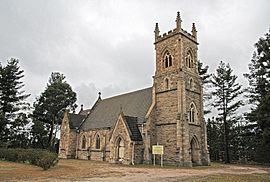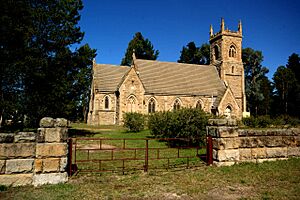St John the Evangelist Church, Wallerawang facts for kids
Quick facts for kids St John the Evangelist Church |
|
|---|---|
| Church of St. John the Evangelist | |

St John the Evangelist Church, in 2010.
|
|
| 33°24′03″S 150°04′40″E / 33.4008°S 150.0777°E | |
| Location | Main Street, Wallerawang, City of Lithgow, New South Wales |
| Country | Australia |
| Denomination | Presbyterian |
| Previous denomination | Anglican (1880–2001) |
| History | |
| Former name(s) | Wallerawang Estate Chapel |
| Status | Church |
| Founded | 28 September 1880 |
| Founder(s) | Georgina Walker-Barton |
| Dedication | John the Evangelist |
| Dedicated | 6 November 1881 |
| Architecture | |
| Functional status | Active |
| Architect(s) |
|
| Architectural type | Church |
| Style | Gothic Revival |
| Years built | 1880–1881 |
| Completed | 6 November 1881 |
| Specifications | |
| Nave width | 16 by 7.3 metres (52 by 24 ft) |
| Height | 15.2 metres (50 ft) |
| Materials | Sandstone |
| Administration | |
| Parish | Lithgow |
| Presbytery | Sydney |
| Division | New South Wales |
St John the Evangelist Church is a very old and special church in Wallerawang, Australia. It's listed on the New South Wales State Heritage Register, which means it's an important historical building. The church was designed by a famous architect named Edmund Blacket and built by George Donald between 1880 and 1881.
This church is unique because it was built for two Christian groups to share: the Anglican and Presbyterian churches. It was closed for repairs in 2001. When it reopened in 2006, only the Presbyterian Church continued to hold services there. Before the church was built, this land was home to Aboriginal people and later became a farm.
Contents
The Story of Wallerawang
What Wallerawang Means
The name Wallerawang comes from the Wiradjuri Aboriginal people. They lived in this area long before European settlers arrived. The name is thought to mean "place near wood and water" or "plenty of water."
Early Settlers and Land
The first European settler in the Wallerawang area was James Walker. He was born in Scotland in 1785. In 1823, he came to New South Wales. The Governor of New South Wales, Governor Brisbane, gave Walker a large piece of land at Wallerawang.
James Walker was a very successful farmer. He raised many sheep and cattle. By 1840, he owned a huge amount of land. He also had a good relationship with his workers and the local Aboriginal people.
A Family's Faith
James Walker was a deeply religious man. He respected both the Church of England (Anglican) and Presbyterian faiths. He built a large house and a church on his land. Ministers from both churches often visited his home. James Walker died in 1856.
St John The Evangelist Church
How the Church Was Built
James Walker's daughter, Georgina Walker-Barton, decided to build St John The Evangelist Church. She wanted it to honor her parents and her late husband. She asked her family friend, Edmund Blacket, a famous church architect, to design it in 1880.
Georgina paid for most of the church's construction. She also built a small brick school nearby, which is still standing today. The church was meant to be a "union" church, meaning both Anglicans and Presbyterians could use it. This was a special idea for the time.
The stone for the church came from a local quarry. The detailed carvings on the pews (church benches) were made from a type of wood called karri. These carvings showed the Scottish heritage of the Walker and Barton families.
The Builder: George Donald
The church was built by George McGarvie Donald. He was a master stonemason and builder from Lithgow. He helped build many important buildings in the area. George Donald was also the first Mayor of Lithgow.
Donald learned his building skills from his father and uncle. He worked on railway projects before starting his own construction business. He built several churches and other important buildings, including the Lithgow Town Hall. He was also very involved in community work.
The foundation stone for St John's Church was laid in 1880. Important religious leaders from both Anglican and Presbyterian churches attended the ceremony.
Church Design and Features
The church was officially opened on 6 November 1881. It was used by both Presbyterian and Anglican groups, showing an early example of different faiths working together.
The church's floor is made from local black Sallee wood. The church bell was made in London in 1880. Inside, you can see many memorials, including plaques and beautiful stained glass windows. The large east window shows prophets, apostles, Christ, and martyrs. This window was put in after Georgina's death in 1906. Another window, installed in 1962, remembers Georgina's daughter, Mary Barton.
The Walker/Barton family cemetery is still located near the church. It is now managed by the Delta Electricity Company.
Sharing the Church
In 1952, the church was officially given to both the Anglican and Presbyterian churches to share. For many years, the Presbyterian minister held regular services. However, the local Anglican church stopped using the building regularly after 1971.
In 1983, a strong storm damaged the church's bell tower. The top of the tower fell and broke part of the roof. The roof and tower were later repaired using special stone.
Around 2001, the church's insurance company said the building needed to be locked. This was because the bell tower had serious cracks and was unsafe. At this time, the church was no longer used for regular services.
Saving the Church
In 2001, there was talk of selling the church. Some even suggested taking it apart or knocking it down. But the Presbyterian church and a group called "Friends of St. John's Church" strongly opposed this. They wanted to save the important building for the community.
Today, the church is owned half by the Friends of St. John's Church and half by the Presbyterian Church NSW. Thanks to the Friends group, who received a special grant, the church was repaired in 2004 and 2005.
St John the Evangelist Church officially reopened on 14 May 2006. Presbyterian services restarted and are now held twice a month. The church is also available for services of all faiths.
Church Description
St John the Evangelist Church is a large and impressive building. It is built in the Victorian Gothic style, which means it has pointed arches and decorative details. The church has a rectangular main body and a tall, square bell tower. It also has smaller side sections called transepts.
The entrance porch is on the street side. The windows are made of sandstone with pointed arches. Some windows have beautiful stained glass, while others have diamond and square panes. The tower has battlements (like a castle) and pinnacles (small spires). It even has interesting animal-face gargoyles! The walls are supported by buttresses.
Key Measurements
- The main part of the church, called the Nave, is about 16 meters long and 7.3 meters wide.
- The Chancel, where the altar is, is about 6 meters long and 5.4 meters wide.
- The Organ chamber and vestry (a room for clergy) are in the transepts.
- The tower is about 15.2 meters high.
Condition of the Church
As of 2002, the church was in fair to poor condition, mainly due to the cracking in the bell tower. However, most of the original building, including the interior designed by Blacket, was still intact.
Why the Church is Special
St John the Evangelist Church is very important for a few reasons:
- Rare Private Gift: It's one of the last major churches in New South Wales built entirely by one person's private donation.
- Shared Faith: It's possibly the only "union" church in the Central West region. This means it was built for two different Christian groups (Anglican and Presbyterian) to share equally.
- Famous Architect: It's a great example of the work of the famous architect Edmund Blacket and his firm.
- Historical Connections: It's connected to the pioneering Walker and Barton families of Lithgow. Edwin Barton was important for surveying railway routes.
- Community Value: The church has been a central place for both Presbyterian and Anglican activities in Wallerawang for over 100 years. It holds many memorials to local people and is highly valued by the community.
- Special Items: The church still has many original items made just for it. These include the main altar, pews, lectern (reader's stand), baptismal font, and other furniture.
St John the Evangelist Church was added to the New South Wales State Heritage Register on 10 September 2004 because of its historical, architectural, and social importance.
Images for kids




